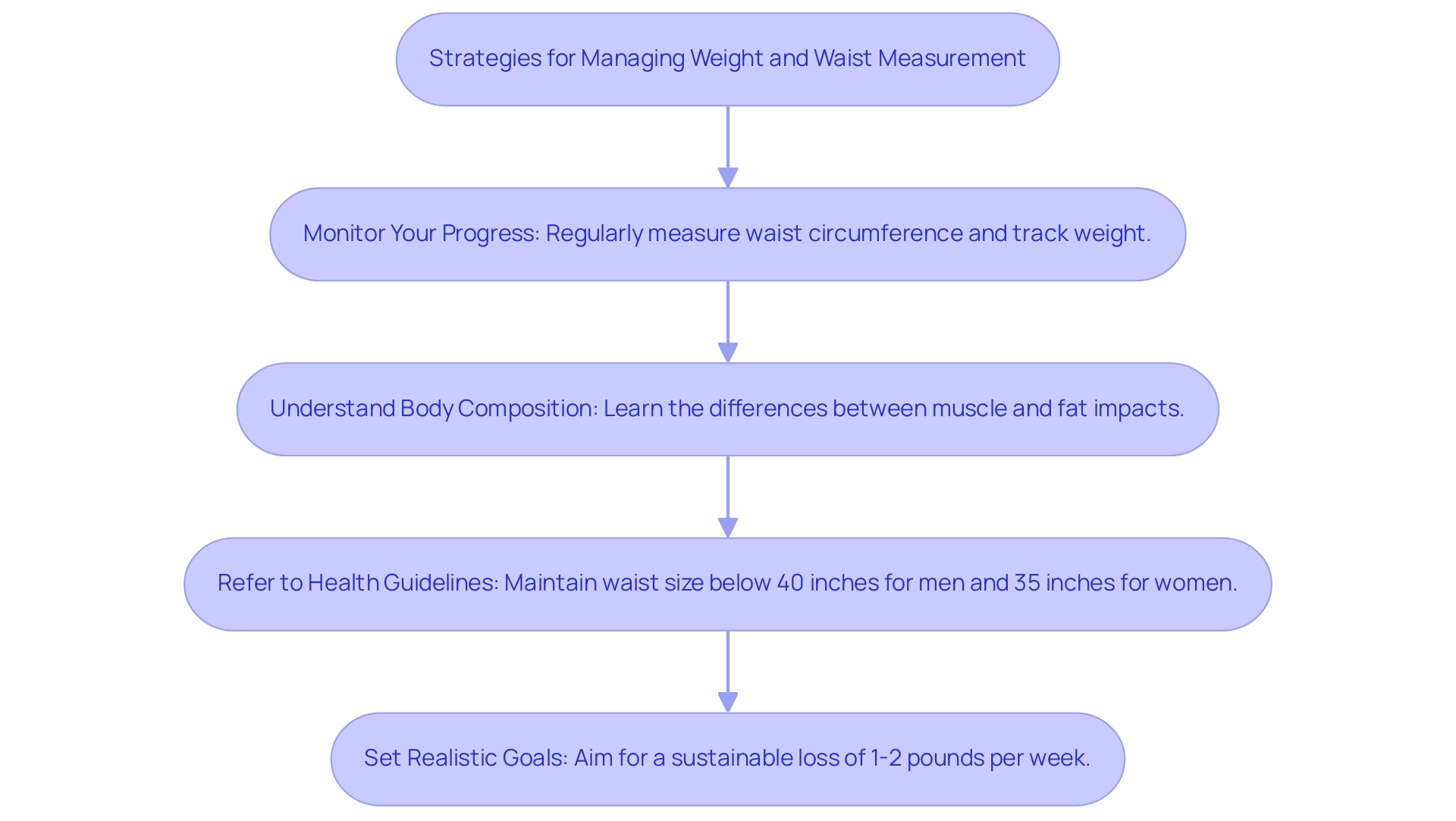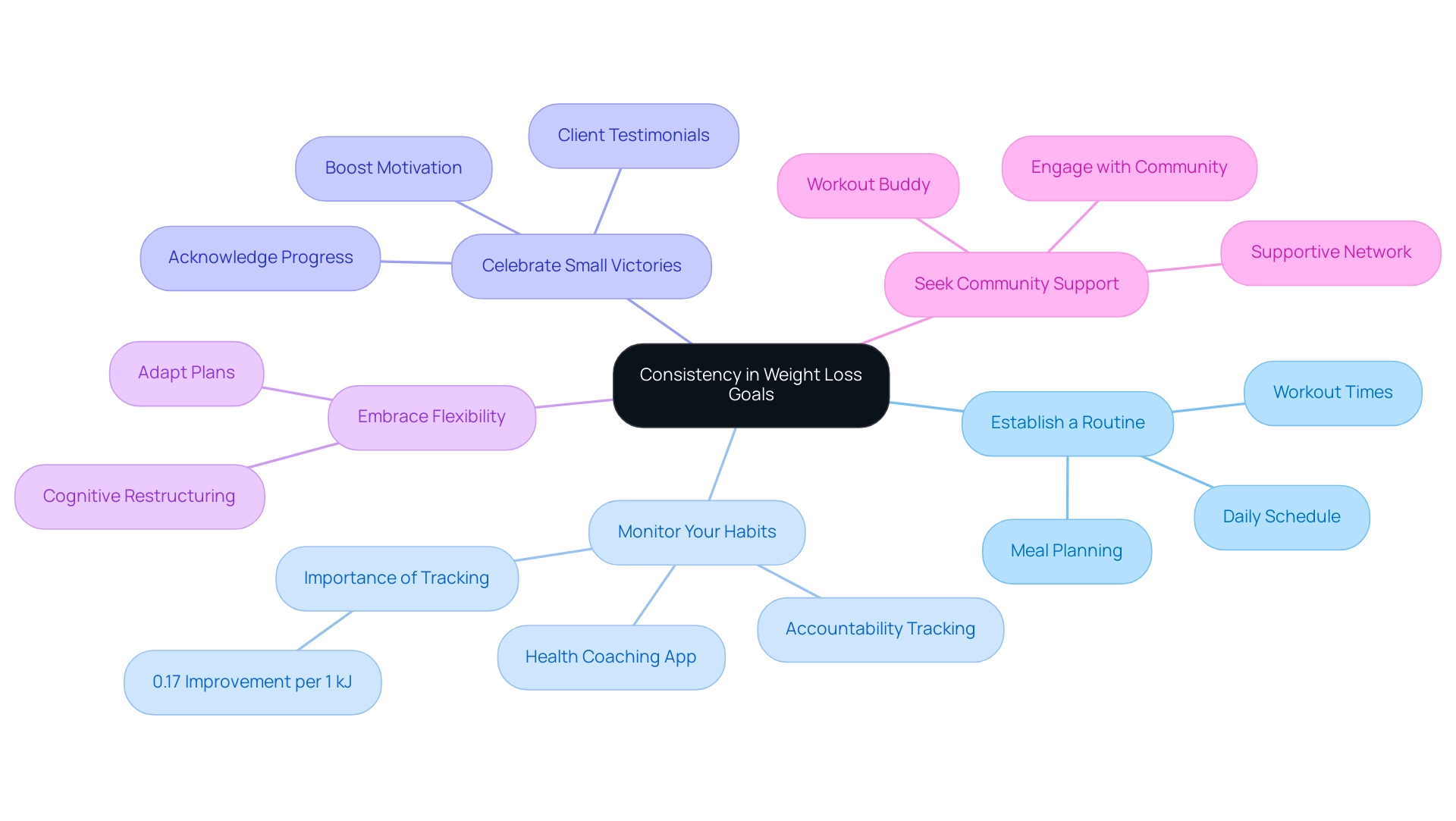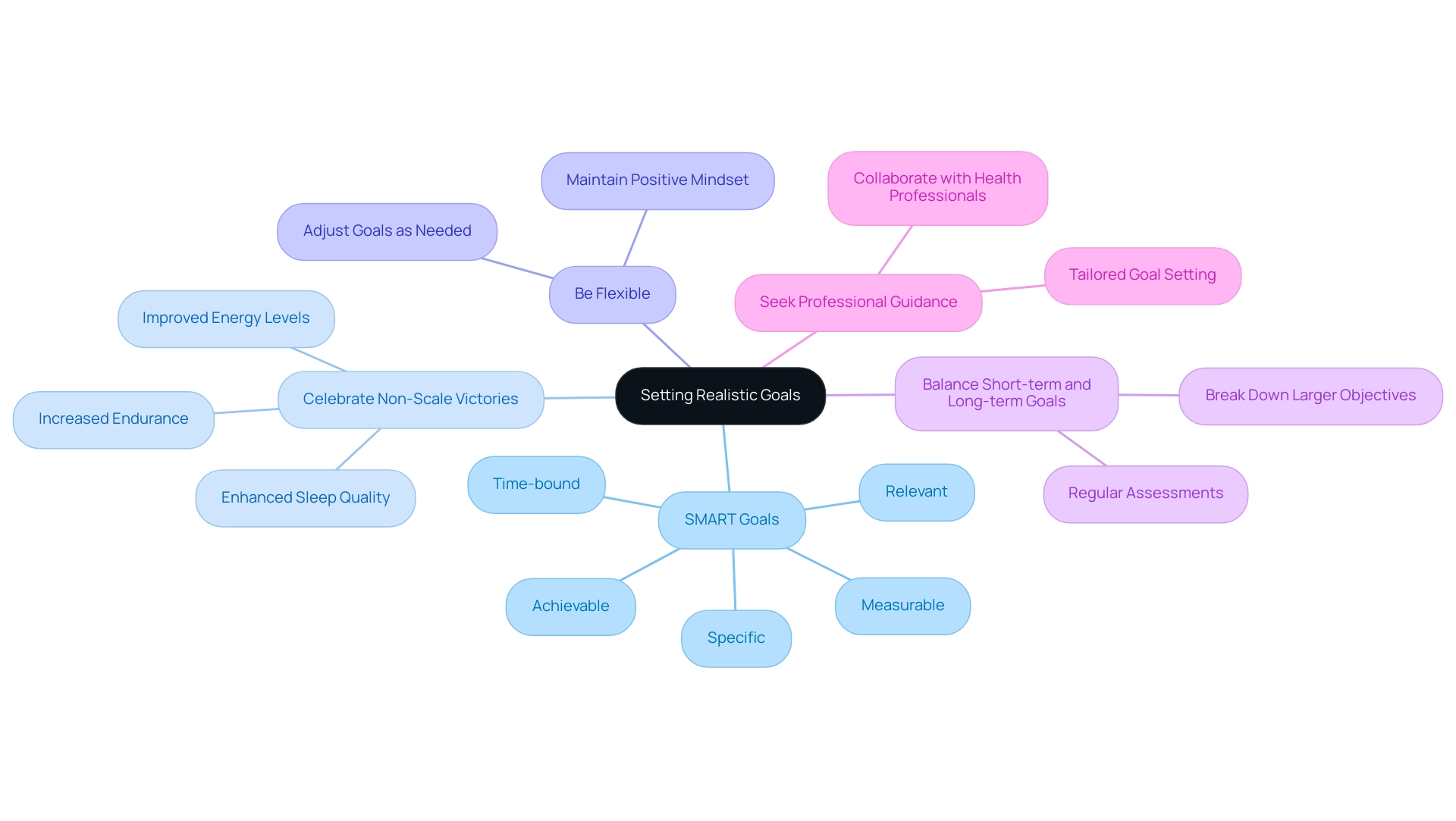Overview
Weight loss is closely related to waist size, with research indicating that losing about 1 to 2 pounds typically results in a reduction of approximately 0.5 to 1 inch off the waist, although individual body composition can influence this relationship. The article supports this by discussing various strategies for effective weight loss, including monitoring progress, understanding body composition, and setting realistic goals, all of which contribute to achieving desired waist measurements and overall health.
Introduction
In the quest for a healthier lifestyle, understanding the intricate relationship between weight loss and waist measurement is essential. Research indicates that shedding just a few pounds can lead to noticeable reductions in waist size, yet individual variations complicate this relationship.
Organizations looking to enhance employee well-being can take proactive steps by implementing effective health management strategies. From tracking progress and understanding body composition to setting realistic goals and incorporating a balanced diet, there are numerous avenues to explore.
As the financial and health implications of obesity loom large, equipping teams with the right tools and support can empower them to embark on their wellness journeys with confidence and determination. Through comprehensive coaching services and targeted initiatives, organizations can foster an environment where health thrives, ultimately benefiting both employees and the workplace as a whole.
Understanding the Weight-Inch Relationship: How Many Pounds Equal an Inch Off Your Waist?
Research demonstrates a compelling relationship between weight loss and waist measurement, specifically addressing how many pounds to lose an inch off your waist, with studies indicating that losing approximately 1 to 2 pounds typically correlates with a reduction of about 0.5 to 1 inch off the waist. However, this relationship can vary based on individual body composition and general well-being. To promote a proactive approach to wellness management within your organization, consider utilizing the comprehensive coaching services offered by Foresight Coaching.
Here are some essential strategies to implement:
- Monitor Your Progress: Regularly measuring your midsection circumference with a tape measure, alongside weight tracking, can provide a comprehensive view of your wellness journey. Foresight’s app-based coaching allows employees to log this data easily.
- Understand Body Composition: Acknowledge that the impacts of muscle versus fat reduction on body measurements vary considerably, with muscle being denser than fat, which can affect your objectives. Our coaching programs include education on body composition to enhance understanding.
- Refer to Health Guidelines: Health experts generally recommend maintaining a waist size of less than 40 inches for men and 35 inches for women, as these benchmarks are associated with reduced health risks. Foresight can provide tailored wellness programs that help employees reach these benchmarks, including in-person wellness talks and nutrition services as part of our corporate membership.
- Set Realistic Goals: Aim for a sustainable loss target of 1-2 pounds per week, while also considering how many pounds to lose an inch off your waist, as individual responses to dietary and exercise changes can vary widely. Our tailored fitness coaching assists in establishing and accomplishing these attainable objectives.
The financial consequences of obesity are considerable, as individuals with obesity spend approximately $2,500 more on medical care for themselves than those of average build. Additionally, obesity is believed to account for around 500,000 fatalities each year in the United States, emphasizing the significant public well-being effect and the need for efficient management strategies. As the World Obesity Federation emphasizes, the global economic consequences of being overweight and obese are expected to surpass $4.3 trillion each year by 2035, highlighting the need for effective strategies in addressing weight management.
Moreover, including fitness metrics such as pushup counts can offer a wider perspective for wellness initiatives. By prioritizing midsection measurement in your wellness initiatives and integrating Foresight's coaching services, including our app-based delivery approach, you can empower your team to achieve improved outcomes and significantly reduce their risk of obesity-related conditions. For more information on how to get started with Foresight Health Coaching, contact us today!

Effective Strategies for Reducing Waist Size: Diet and Exercise Tips
To effectively reduce waist size and enhance holistic health and well-being, consider implementing the following strategies supported by our comprehensive wellness coaching app, which consolidates all the tools you need in one convenient location:
-
Adopt a Balanced Diet: Embrace whole, unprocessed foods, prioritizing an abundance of fruits, vegetables, lean proteins, and whole grains. Reducing refined carbohydrates and sugars can significantly aid in decreasing abdominal circumference. Our app provides tailored nutrition guidance to support these dietary choices. Notably, studies indicate that the association between GDS-WC and circumference around the abdomen was higher in abdominally obese participants (−0.31 cm; 95% CI −0.41, −0.22 cm; p < 0.0001), underscoring the importance of dietary patterns in managing obesity. The app can help you implement these patterns effectively, as highlighted in the case study "Longitudinal Analysis of Dietary Patterns and Obesity," which emphasizes the importance of dietary patterns over individual food items in preventing obesity.
-
Control Portion Sizes: Mindful eating is key. Be conscious of portion sizes to prevent overeating, and consider using smaller plates to help manage your portions effectively. The app's daily programming feature can assist in tracking your food intake, making this simple change more manageable and impactful in your weight loss journey.
-
Stay Hydrated: Ensure adequate hydration throughout the day. Drinking water can help control hunger and support metabolic efficiency, making it easier to maintain a healthy body size. Our app reminds you to stay hydrated and offers tips on fluid intake.
-
Incorporate Regular Exercise: Commit to at least 150 minutes of moderate aerobic activity weekly, such as brisk walking or cycling. Additionally, engage in strength training exercises twice a week to build muscle mass and boost metabolism, which are crucial for reducing body size. With personalized workouts available at your fingertips, the app ensures you stay on track with your fitness goals.
-
Practice Stress Management: Recognize the impact of stress on body size. High stress levels can lead to increased abdominal fat. Incorporate stress-relief techniques such as yoga, meditation, or deep breathing exercises into your daily routine. The app provides access to guided sessions that promote mental and physical well-being.
-
Get Enough Sleep: Quality sleep is essential for weight loss success. Aim for 7-9 hours of restful sleep each night, as insufficient rest can undermine your efforts and contribute to increased body size. The app's wellness resources can assist you in developing healthy sleep habits, improving your overall condition and supporting your waist-reduction goals.
By incorporating these strategies into your routine, enhanced by the extensive functionalities of our wellness coaching application, you can efficiently strive to decrease your midsection size and learn how many pounds to lose an inch off your waist to enhance your overall well-being.
![]()
The Role of Consistency in Achieving Weight Loss Goals
Attaining fat loss and waist size reduction is a journey that relies on consistency and personalized support. Here are essential strategies to help maintain that consistency:
- Establish a Routine: Create a daily schedule that incorporates meal planning and designated workout times. This structure fosters accountability and helps you stay on track, just like the personalized coaching we offer.
- Monitor Your Habits: Utilize our health coaching app to document your food intake and physical activities. Keeping a record is crucial for accountability and can significantly enhance your success rates. Notably, studies indicate that the percent mass lost improves by 0.17 for every 1 kJ enhancement in variability, underscoring the importance of tracking.
- Celebrate Small Victories: Recognize and celebrate every achievement, no matter how minor. Acknowledging progress boosts motivation and reinforces positive behaviors, a principle that our experienced coaches emphasize during your journey. One client shared, "I started recognizing my small wins, and it motivated me to keep going!"
- Embrace Flexibility: Life can be unpredictable, so it's vital to adapt your plans as circumstances change while remaining focused on your ultimate goals. Our coaching approach encourages this adaptability, utilizing techniques such as cognitive restructuring to help clients adjust their mindset.
- Seek Community Support: Engage with a community or partner with a workout buddy. Sharing your journey fosters a space of mutual encouragement, making the loss process more enjoyable. Our app also connects you with others on similar paths, fostering a supportive network.
As highlighted in a study on successful maintenance titled 'Recovery from Relapse among Successful Maintainers,' where 2400 participants had lost an average of 32.1 kg and maintained this for over 6 years, consistency plays a pivotal role in long-term success. While many experienced minor regain, the key to recovery lies in consistent tracking and adaptation. As Cheryl F. Smith aptly stated, "Duration of the vegetarian diet was much greater than the weight-loss diet," emphasizing the importance of sustained commitment.
Remember, every step you take towards consistency, supported by our coaching, is a step towards achieving your wellness goals. Start today with our free 7-day trial and transform your approach to wellness!

Understanding Metabolism and Its Impact on Weight Loss
Metabolism is a crucial factor in how the body processes food and burns calories, significantly influencing loss efforts. However, it’s important to recognize that regular exercise plays a pivotal role not only in metabolism but also in enhancing workplace performance and motivation. Understanding these nuances can empower you to support your team’s health effectively.
Here are some key points to consider:
- Basal Metabolic Rate (BMR): This represents the number of calories your body requires at rest to sustain essential functions. Notably, factors such as age, gender, and muscle mass play critical roles in determining BMR. For example, studies show that African Americans generally possess a resting metabolic rate (RMR) that is 10%–20% lower than that of Caucasians, emphasizing the necessity for customized strategies in management.
- Active Metabolism: Participating in physical exercise helps to boost metabolic rate, which is essential for reducing body mass. Furthermore, studies published in journals like “Workplace Health & Safety” have shown that employees who exercise regularly report feeling more motivated and engaged at work. Incorporating both aerobic exercises and strength training into daily routines can significantly enhance calorie burn and foster a motivated workforce. Additionally, such exercise programs have been linked to reductions in absenteeism and presenteeism, further improving workplace productivity.
- Nutrition’s Role: Consuming adequate protein is essential for maintaining muscle mass, which directly boosts metabolism. It is essential to avoid extreme calorie restrictions, as these can lead to a slowdown in metabolic function, undermining loss efforts. A balanced diet that supports energy needs while fostering muscle retention is key to both health and workplace productivity.
- Genetic Factors: Genetics can play a significant role in determining metabolic rates, meaning some individuals may find it easier or more challenging to reduce body mass. Recognizing these differences can help tailor interventions more effectively, enhancing overall team engagement.
- Age Considerations: Metabolism generally slows down with age, necessitating adjustments in dietary and exercise habits as one matures. Understanding the average BMR by age and gender can guide personalized strategies that cater to these changes, ultimately improving employee satisfaction.
- Sleep and Metabolism: Adequate sleep is crucial for energy metabolism. Inadequate sleep can lead to increased body mass and diminished motivation, highlighting the significance of rest in management strategies and employee well-being.
- Public Well-Being Implications: The case study titled "Public Well-Being Implications of RMR Estimates" emphasizes the significance of accurate RMR estimates for public well-being interventions aimed at preventing chronic diseases like diabetes, particularly among high-risk groups. Inaccurate RMR estimations could lead to miscalculations in intervention outcomes, highlighting the need for tailored RMR values based on demographic and anthropometric characteristics.
By understanding these ideas, you can cultivate a setting that emphasizes health and well-being, ultimately assisting your team in their fitness journeys. As Monda et al. state, it is important to maintain muscle mass, as it contributes to a potentially greater sympathetic tone, bolstering metabolic functions essential for managing body composition and enhancing workplace motivation.

The Importance of Setting Realistic Goals
Attaining long-term success in reducing body mass necessitates a strategic method for goal establishment. Here are some impactful strategies to consider, enhanced by the comprehensive health coaching services offered by Foresight Health Coaching:
- SMART Goals: Embrace the SMART framework—Specific, Measurable, Achievable, Relevant, Time-bound—to clearly define your body transformation objectives. This structured approach not only clarifies your targets but also sets the stage for measurable progress, supported by tailored coaching programs designed to meet individual and corporate needs.
- Celebrate Non-Scale Victories: Shift your focus beyond the scale by recognizing other significant achievements. Improved energy levels, enhanced sleep quality, and increased endurance are all indicators of progress that deserve celebration, reinforcing your commitment to a healthier lifestyle. Foresight's app-based delivery ensures you track these victories seamlessly, allowing you to log and celebrate achievements in real-time.
- Be Flexible: Stay open to adjusting your goals based on your evolving progress and personal circumstances. Flexibility is crucial; adapting your targets fosters a positive mindset and keeps motivation high. Personalized coaching at Foresight allows for this adaptability, offering ongoing support and adjustments to your plan as needed.
- Balance Short-term and Long-term Goals: Break down larger objectives into smaller, manageable milestones. This approach allows for regular assessments of your journey and provides opportunities to celebrate successes along the way, facilitated by Foresight's structured wellness programs, which include in-person wellness talks and nutrition services for corporate members.
- Seek Professional Guidance: Collaborate with health professionals or wellness coaches to set realistic goals tailored specifically to your individual needs and lifestyle. The knowledge offered by Foresight Health Coaching can assist you in overcoming obstacles and enhancing your journey towards a healthier lifestyle, guaranteeing that you receive the appropriate support at each stage.
Recent research emphasizes the effectiveness of higher reduction targets. Current guidelines recommending a 5%-10% weight loss goal may need reconsideration in favor of encouraging larger goals, as a study involving over 36,000 participants found that those setting targets beyond 10% of their body weight achieved greater weight loss and reported lower dropout rates. Specifically, participants driven by fitness or well-being were less likely to drop out, with odds ratios of 0.92 (95% CI 0.85-0.995; p=.04) and 0.84 (95% CI 0.78-0.89; p<.001).
As Paul Y Takahashi notes, > This study was registered at ClinicalTrials.gov (NCT01833507) <, emphasizing the scientific backing for these findings. By motivating yourself with fitness or health, rather than appearance alone, you can significantly enhance your commitment to your goals, as shown by participants who were less likely to drop out when driven by health-related aspirations. Additionally, the case study titled "Influence of Goal Setting on Weight Loss" illustrates the positive impact of higher goal setting on weight loss outcomes, supporting the argument for encouraging larger weight loss targets.

Conclusion
The journey towards a healthier lifestyle is deeply intertwined with understanding the dynamics of weight loss and waist measurements. Research reveals that even modest weight loss can lead to significant reductions in waist size, emphasizing the importance of individual body composition in this relationship. Organizations have a unique opportunity to enhance employee well-being by implementing effective health management strategies, such as:
- Tracking progress
- Understanding body composition
- Setting realistic goals
By adopting a balanced diet and incorporating regular exercise, employees can effectively reduce their waist size and improve overall health. The role of consistency cannot be overstated; establishing routines, monitoring habits, and celebrating small victories are essential for maintaining motivation on this journey. Furthermore, understanding metabolism and its impact on weight loss can empower teams to make informed choices that benefit both their health and workplace performance.
Ultimately, setting realistic and achievable goals is crucial for long-term success. By embracing a comprehensive approach that includes professional guidance and community support, organizations can foster a culture of health that not only improves individual well-being but also enhances workplace productivity. Now is the time to take action and prioritize wellness initiatives that empower employees to embark on their health journeys with confidence and determination.




